系统评价Meta分析常用质量评价工具简介
- 格式:ppt
- 大小:367.50 KB
- 文档页数:41
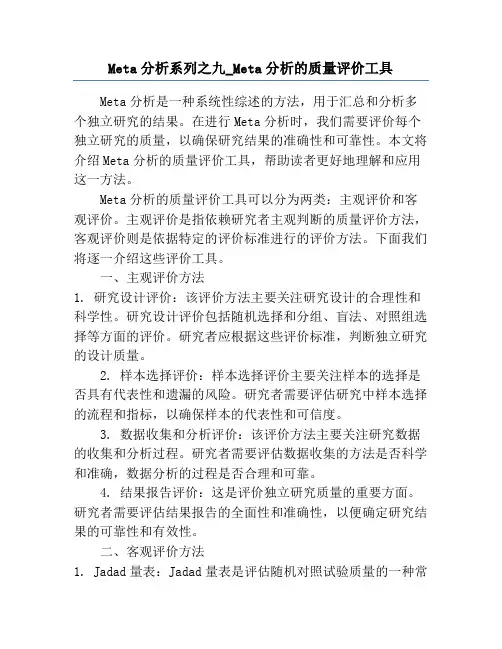
Meta分析系列之九_Meta分析的质量评价工具Meta分析是一种系统性综述的方法,用于汇总和分析多个独立研究的结果。
在进行Meta分析时,我们需要评价每个独立研究的质量,以确保研究结果的准确性和可靠性。
本文将介绍Meta分析的质量评价工具,帮助读者更好地理解和应用这一方法。
Meta分析的质量评价工具可以分为两类:主观评价和客观评价。
主观评价是指依赖研究者主观判断的质量评价方法,客观评价则是依据特定的评价标准进行的评价方法。
下面我们将逐一介绍这些评价工具。
一、主观评价方法1. 研究设计评价:该评价方法主要关注研究设计的合理性和科学性。
研究设计评价包括随机选择和分组、盲法、对照组选择等方面的评价。
研究者应根据这些评价标准,判断独立研究的设计质量。
2. 样本选择评价:样本选择评价主要关注样本的选择是否具有代表性和遗漏的风险。
研究者需要评估研究中样本选择的流程和指标,以确保样本的代表性和可信度。
3. 数据收集和分析评价:该评价方法主要关注研究数据的收集和分析过程。
研究者需要评估数据收集的方法是否科学和准确,数据分析的过程是否合理和可靠。
4. 结果报告评价:这是评价独立研究质量的重要方面。
研究者需要评估结果报告的全面性和准确性,以便确定研究结果的可靠性和有效性。
二、客观评价方法1. Jadad量表:Jadad量表是评估随机对照试验质量的一种常用工具。
该量表包括随机化、盲法和退出情况三个方面的评估指标,每个指标按照质量评分制度进行评分。
2. Newcastle-Ottawa量表:Newcastle-Ottawa量表是一种评估非随机对照试验和队列研究质量的工具。
该量表包括选择比较组、比较组的选择、暴露因素和结果的评估指标等内容。
3. Cochrane Collaboration工具:Cochrane Collaboration提供了一套用于评估系统评价和Meta分析质量的工具。
这些工具包括清晰的评估指标和评估标准,研究者可以根据这些指标和标准进行客观评估。
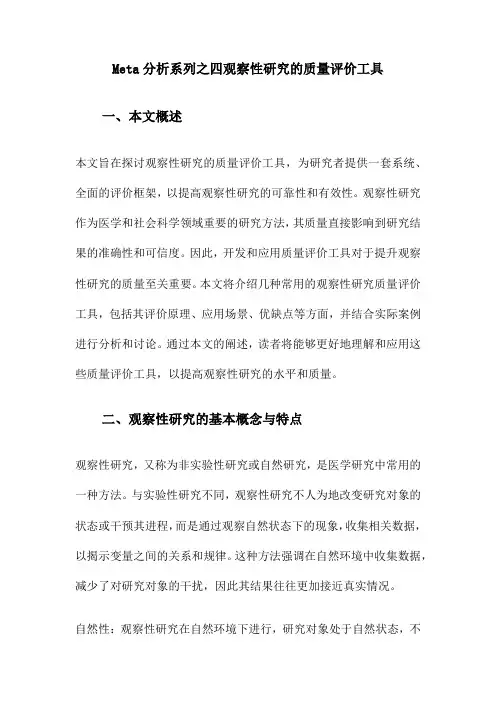
Meta分析系列之四观察性研究的质量评价工具一、本文概述本文旨在探讨观察性研究的质量评价工具,为研究者提供一套系统、全面的评价框架,以提高观察性研究的可靠性和有效性。
观察性研究作为医学和社会科学领域重要的研究方法,其质量直接影响到研究结果的准确性和可信度。
因此,开发和应用质量评价工具对于提升观察性研究的质量至关重要。
本文将介绍几种常用的观察性研究质量评价工具,包括其评价原理、应用场景、优缺点等方面,并结合实际案例进行分析和讨论。
通过本文的阐述,读者将能够更好地理解和应用这些质量评价工具,以提高观察性研究的水平和质量。
二、观察性研究的基本概念与特点观察性研究,又称为非实验性研究或自然研究,是医学研究中常用的一种方法。
与实验性研究不同,观察性研究不人为地改变研究对象的状态或干预其进程,而是通过观察自然状态下的现象,收集相关数据,以揭示变量之间的关系和规律。
这种方法强调在自然环境中收集数据,减少了对研究对象的干扰,因此其结果往往更加接近真实情况。
自然性:观察性研究在自然环境下进行,研究对象处于自然状态,不受人为干预的影响。
这有助于获得更真实、更贴近实际的数据。
灵活性:观察性研究可以根据研究目的和问题的不同,选择不同的研究对象、观察指标和数据收集方法。
这种灵活性使得观察性研究能够适应各种复杂的研究场景。
广泛性:观察性研究可以涵盖大量的研究对象和多种不同的观察指标,从而提供丰富的数据支持。
这种广泛性有助于揭示变量之间的复杂关系,为深入研究奠定基础。
实时性:观察性研究能够实时跟踪研究对象的变化,及时捕捉各种现象和事件。
这种实时性有助于获取最新的研究数据,为决策提供有力支持。
然而,观察性研究也存在一些局限性。
由于缺乏对研究对象的干预和控制,观察性研究可能受到多种未知因素的影响,导致结果产生偏差。
观察性研究通常需要较长的时间来收集数据,因此耗时较长。
对于某些特定的问题或疾病,观察性研究可能难以获得足够数量和质量的数据支持。
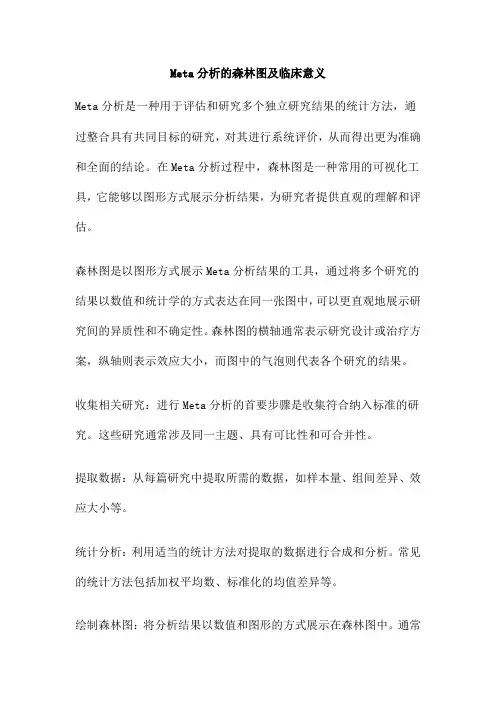
Meta分析的森林图及临床意义Meta分析是一种用于评估和研究多个独立研究结果的统计方法,通过整合具有共同目标的研究,对其进行系统评价,从而得出更为准确和全面的结论。
在Meta分析过程中,森林图是一种常用的可视化工具,它能够以图形方式展示分析结果,为研究者提供直观的理解和评估。
森林图是以图形方式展示Meta分析结果的工具,通过将多个研究的结果以数值和统计学的方式表达在同一张图中,可以更直观地展示研究间的异质性和不确定性。
森林图的横轴通常表示研究设计或治疗方案,纵轴则表示效应大小,而图中的气泡则代表各个研究的结果。
收集相关研究:进行Meta分析的首要步骤是收集符合纳入标准的研究。
这些研究通常涉及同一主题、具有可比性和可合并性。
提取数据:从每篇研究中提取所需的数据,如样本量、组间差异、效应大小等。
统计分析:利用适当的统计方法对提取的数据进行合成和分析。
常见的统计方法包括加权平均数、标准化的均值差异等。
绘制森林图:将分析结果以数值和图形的方式展示在森林图中。
通常使用统计软件如Stata、R或Excel等来绘制图形。
森林图在临床研究中的应用具有重要意义。
它能够直观地展示多个研究的合并结果,帮助临床医生全面了解治疗效果。
森林图可以揭示研究间的异质性,这有助于解释结果的不确定性。
森林图还可以用于评估某些干预措施的效果,为临床决策提供依据。
例如,在评价某种新药的疗效时,可以收集多个临床试验数据,通过Meta分析得出该药物相对于对照组的疗效差异。
然后,利用森林图展示合并后的结果,帮助医生全面了解该药物的疗效,从而制定更为准确的诊疗方案。
同时,通过观察森林图中的气泡分布,还可以了解到各研究之间的异质性,进一步探讨其潜在影响因素。
Meta分析的森林图是一种有效的可视化工具,用于展示和评估多个独立研究结果的合并统计量。
在制作和分析森林图的过程中,需要经过数据收集、提取、统计分析和图形绘制等步骤。
森林图在临床研究中的应用具有重要意义,它能够直观地展示治疗效果,揭示研究间的异质性,并为临床决策提供依据。
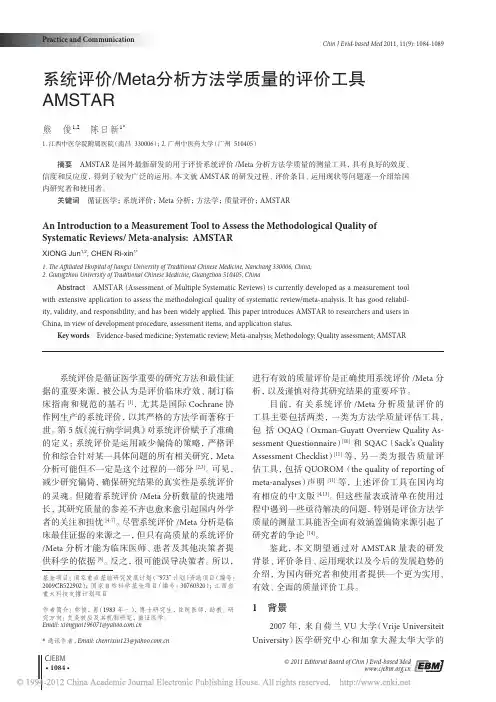
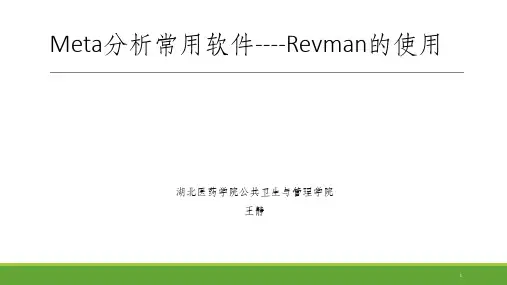
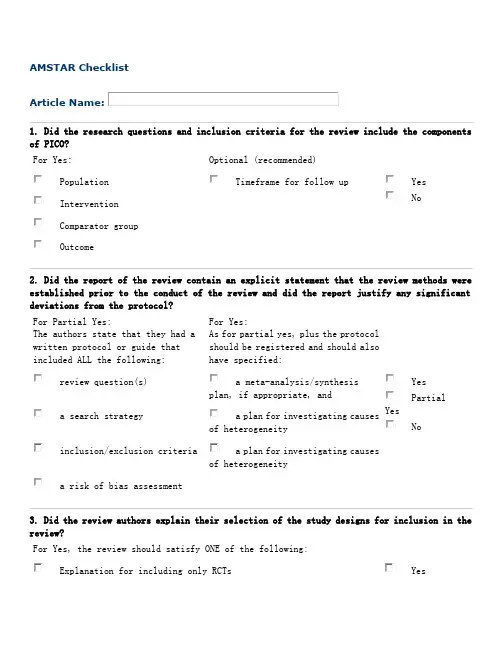
AMSTAR ChecklistArticle Name:1. Did the research questions and inclusion criteria for the review include the components of PICO?For Yes: Optional (recommended)PopulationTimeframe for follow upYesNo InterventionComparator groupOutcome2. Did the report of the review contain an explicit statement that the review methods were established prior to the conduct of the review and did the report justify any significant deviations from the protocol?For Partial Yes:The authors state that they had awritten protocol or guide thatincluded ALL the following:For Yes:As for partial yes, plus the protocolshould be registered and should alsohave specified:review question(s)a meta-analysis/synthesisplan, if appropriate, andYesPartialYesNoa search strategy a plan for investigating causesof heterogeneityinclusion/exclusion criteria a plan for investigating causesof heterogeneitya risk of bias assessment3. Did the review authors explain their selection of the study designs for inclusion in the review?For Yes, the review should satisfy ONE of the following:Explanation for including only RCTs YesOR Explanation for including only NRSINoOR Explanation for including both RCTs and NRSI4. Did the review authors use a comprehensive literature search strategy? For Partial Yes (all the following): For Yes, should also have (all the following):searched at least 2 databases (relevant to research question) searched the reference lists / bibliographies of included studies YesPartialYesNoprovided key word and/or search strategy searched trial/study registriesjustified publication restrictions (e.g. language) included/consulted content experts in the fieldwhere relevant, searched for grey literatureconducted search within 24 months of completion of the review5. Did the review authors perform study selection in duplicate? For Yes, either ONE of the following:at least two reviewers independently agreed on selection of eligible studies and achieved consensus on which studies to includeYesNoOR two reviewers selected a sample of eligible studies and achieved good agreement (at least 80 percent), with the remainder selected by one reviewer.6. Did the review authors perform data extraction in duplicate? For Yes, either ONE of the following:at least two reviewers achieved consensus on which data to extract from included studiesYesNoOR two reviewers extracted data from a sample of eligible studiesand achieved good agreement (at least 80 percent), with the remainder extracted by one reviewer.7. Did the review authors provide a list of excluded studies and justify the exclusions? For Partial Yes:For Yes, must also have:provided a list of all potentially relevant studies that were read in full-text form butexcluded from the reviewJustified the exclusion from thereview of each potentially relevant studyYes Partial Yes No8. Did the review authors describe the included studies in adequate detail?For Partial Yes (ALL thefollowing): For Yes, should also have ALL the following:described populations described populationin detail YesPartial YesNodescribed interventionsdescribed intervention in detail (including doses where relevant)described comparatorsdescribed comparatorin detail(including doses where relevant)described outcomesdescribed study’s setting described research designstimeframe for follow-up9. Did the review authors use a satisfactory technique for assessing the risk of bias (RoB) in individual studies that were included in the review? RCTsFor Partial Yes, must have assessed RoB fromFor Yes, must also have assessed RoB from:unconcealed allocation, andallocation sequence that wasnot truly random, andYesPartial YesNolack of blinding of patients and assessors when assessing selection of the reported result from among multipleoutcomes (unnecessary for objective outcomes such as all-cause mortality) measurements or analyses of aspecified outcome Includes only NRSI NRSIFor Partial Yes, must have assessed RoB:For Yes, must also have assessed RoB:from confounding, andmethods used to ascertainexposures and outcomes, and YesPartial YesNoIncludesonly RCTsfrom selection biasselection of the reported result from among multiple measurements or analyses of a specified outcome10. Did the review authors report on the sources of funding for the studies included in the review? For YesMust have reported on the sources of funding for individual studies included in the review. Note: Reporting that the reviewers looked for this information but it was not reported by study authors also qualifiesYes No11. If meta-analysis was performed did the review authors use appropriate methods for statistical combination of results?RCTs For Yes:The authors justified combining the data in a meta-analysis YesNo Nometa-analysis conducted AND they used an appropriate weighted technique to combine study results and adjusted for heterogeneity if present.AND investigated the causes of any heterogeneity For NRSI For Yes:The authors justified combining the data in a meta-analysisYes NoNometa-analysisconducted AND they used an appropriate weighted technique to combine study results, adjusting for heterogeneity if presentAND they statistically combinedeffect estimates from NRSI that were adjusted for confounding, rather than combining raw data, or justified combining raw data when adjusted effect estimates were not available AND they reported separate summary estimates for RCTs and NRSI separately when both were included in the review12. If meta-analysis was performed, did the review authors assessthe potential impact of RoB in individual studies on the results of the meta-analysis or other evidence synthesis?For Yes:included only low risk of bias RCTsYesNoNo meta-analysis conductedOR, if the pooled estimate was based on RCTs and/or NRSI at variableRoB, the authors performed analyses to investigate possible impact of RoBon summary estimates of effect.13. Did the review authors account for RoB in individualstudies when interpreting/ discussing the results of the review?For Yes:included only low risk of bias RCTsYes NoOR, if RCTs with moderate or high RoB, or NRSI were included the review provided a discussion of the likely impact of RoB on the results14. Did the review authors provide a satisfactory explanation for, and discussion of, any heterogeneity observed in the results of the review?For Yes:There was no significant heterogeneity in the resultsYes NoOR if heterogeneity was present the authors performed aninvestigation of sources of any heterogeneity in the results and discussed the impact of this on the results of the review15. If they performed quantitative synthesis did the review authors carry out an adequate investigation of publication bias (small study bias) and discuss its likely impact on the results of the review? For Yes:performed graphical or statistical tests for publication bias anddiscussed the likelihood and magnitude of impact of publication biasYes No Nometa-analysis conducted16. Did the review authors report any potential sources of conflict of interest, including any funding they received for conducting the review? For Yes:The authors reported no competing interests ORYesNoThe authors described their funding sources and how they managed potential conflicts of interestTo cite this tool: Shea BJ, Reeves BC, Wells G, Thuku M, Hamel C, Moran J, Moher D, Tugwell P, Welch V, Kristjansson E, Henry DA. AMSTAR 2: a critical appraisal tool for systematic reviews that include randomised or non-randomised studies of healthcare interventions, or both. BMJ. 2017 Sep 21;358:j4008.。
![[循证理论与实践]Meta分析系列之四:观察性研究的质量评价工具](https://uimg.taocdn.com/318f2c4e814d2b160b4e767f5acfa1c7aa0082e8.webp)
[循证理论与实践]Meta分析系列之四:观察性研究的质量评价⼯
具
STROBE声明是⽤来规范观察性研究报告格式的,包括队列研究、病例-对照研究及横断⾯研究,⾃然也可以⽤来评估这些类型研究的质量;对于分⼦流⾏病学观察性研究,亦可以采⽤其报告规范,STROBE的扩展版(STROBE-ME)。
STREGA声明也属于STROBE的扩展版,是专为规范遗传学关联研究的报告规范,亦可以⽤来评估遗传关联性研究的质量。
因其不是专⽤于评价观察性研究的质量,故在此不详细列出。
5 结 语
常⽤于meta分析的观察性研究包括队列研究、病例-对照研究及横断⾯研究三⼤类,因这三类研究受偏倚影响的程度依次增加,⽬前尚⽆⼀种通⽤的评价⼯具。
NOS的制作很好地结合了病例对照研究和队列研究的实际,从随机对照试验评价⽅法中得以引申,能较好地应⽤于⾮随机对照试验的系统评价,已被Cochrane协作⽹的⾮随机研究⽅法学组⽤于培训中并推荐使⽤。
CASP⽬前应⽤最多的国是英国及加拿⼤。
AHRQ横断⾯研究评价标准较为客观。
我们建议选择NOS评价队列研究和病例-对照研究;选择AHRQ横断⾯研究评价标准评价横断⾯研究;在临床循证时针对单个队列研究或病例-对照研究则推荐选择CASP清单,因为它考虑了研究的外部适⽤性。
⽂章摘⾃:曾宪涛,刘慧,陈曦,冷卫东,Meta分析系列之四:观察性研究的质量评价⼯具[J],中国循证⼼⾎管医学杂志2012 年8⽉第4 卷 第4 期,295-297.。
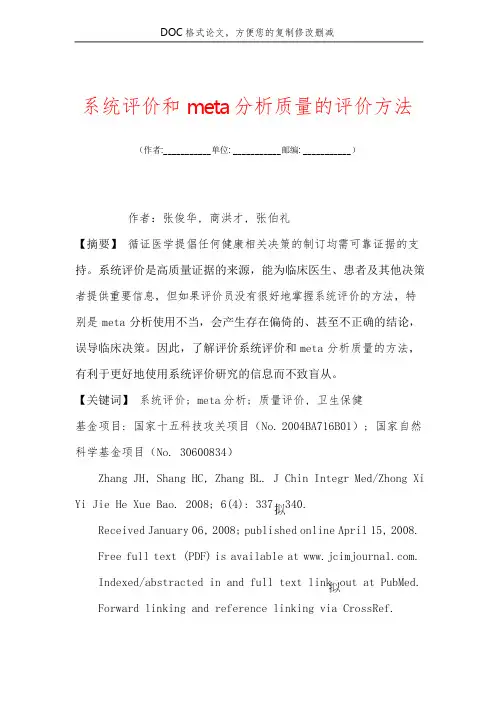
系统评价和meta分析质量的评价方法(作者:___________单位:___________邮编:___________)作者:张俊华,商洪才,张伯礼【摘要】循证医学提倡任何健康相关决策的制订均需可靠证据的支持。
系统评价是高质量证据的来源,能为临床医生、患者及其他决策者提供重要信息,但如果评价员没有很好地掌握系统评价的方法,特别是meta分析使用不当,会产生存在偏倚的、甚至不正确的结论,误导临床决策。
因此,了解评价系统评价和meta分析质量的方法,有利于更好地使用系统评价研究的信息而不致盲从。
【关键词】系统评价;meta分析;质量评价,卫生保健基金项目:国家十五科技攻关项目(No.2004BA716B01);国家自然科学基金项目(No.30600834)Zhang JH,Shang HC,Zhang BL.J Chin Integr Med/Zhong Xi Yi Jie He Xue Bao.2008;6(4):337340.Received January06,2008;published online April15,2008.Free full text(PDF)is available at .Indexed/abstracted in and full text link out at PubMed.Forward linking and reference linking via CrossRef.DOI:10.3736/jcim20080402Open AccessHow to assess the quality of systematic review and meta analysisJun hua ZHANG,Hong cai SHANG,Bo li ZHANG1.Evidence Based Medicine Center,Tianjin University of Traditional Chinese Medicine,Tianjin300193,China2.Research Center of Traditional Chinese Medicine, Tianjin University of Traditional Chinese Medicine,Tianjin 300193,ChinaAbstract:Evidence based medicine advocates that decision making should be based on the adequate evidence.High quality systematic review is an important source of information for clinicians,patients,governments and other decision makers in decision making.If reviewers couldn’t master the correct method of systematic review or meta analysis was misused,the inaccurate,biased or misleading outcomes would be produced.So understanding of the methods of evaluating the quality of systematic review and meta analysis is helpful to make good use of the review’s information.Keywords:systematic review;meta analysis;quality assessment,health care系统评价(systematic review)是一种按照严格的纳入标准,广泛收集关于某一医疗卫生问题的所有研究,对纳入研究进行全面的质量评价,并进行定性分析,研究间具有足够同质性时进行定量数据合并,以对该问题进行系统总结的研究方法。

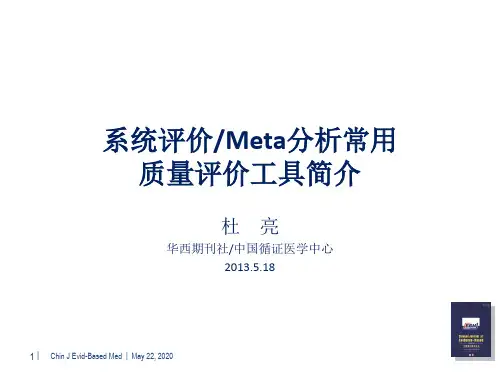

Meta分析系列之二Meta分析的软件一、本文概述随着医学和科研领域的快速发展,越来越多的研究者在面对大量的研究数据时,需要一种有效且科学的方法来进行综合分析和评价。
Meta 分析作为一种重要的统计学方法,能够通过整合多个独立研究的结果,提供更可靠、更有说服力的证据。
然而,要进行Meta分析,除了掌握其基本原理和方法外,还需要合适的软件工具来辅助实现。
本文将详细介绍几种常用的Meta分析软件,包括其特点、适用场景以及操作步骤,帮助读者更好地选择和应用这些软件,提高Meta分析的效率和准确性。
二、Meta分析软件概览随着统计软件和计算机技术的不断发展,越来越多的专业软件被开发出来用于执行Meta分析。
这些软件不仅提高了Meta分析的效率和精度,也使得复杂的数据处理和分析过程变得相对简单和直观。
以下是对一些常用的Meta分析软件的概览。
Stata:Stata是一款功能强大的统计软件,其内置的meta命令可以方便地进行Meta分析。
Stata提供了多种Meta分析方法,包括固定效应模型、随机效应模型等,同时也支持对异质性、发表偏倚等进行检验和处理。
Stata的图形化界面使得操作更加直观,适合初学者使用。
RevMan:RevMan(Review Manager)是由Cochrane协作网开发的一款免费的Meta分析软件。
它提供了全面的Meta分析功能,包括数据输入、数据分析、图形生成等。
RevMan还支持对研究质量进行评估,提供了一系列工具和指南帮助研究者进行高质量的Meta分析。
R语言:R语言是一款开源的统计软件,其强大的编程能力和丰富的包资源使得它在Meta分析领域具有广泛的应用。
通过安装相应的包,如“metafor”“meta”等,可以轻松进行各种复杂的Meta分析。
R 语言的灵活性使得研究者可以根据需要进行自定义分析,但同时也需要一定的编程基础。
SAS:SAS是一款商业统计软件,其PROC MIED和PROC GLM过程可以用于执行Meta分析。
Meta分析系列之二:Meta分析的软件Meta分析系列之二: Meta分析的软件概述:Meta分析是一种系统回顾和整合已有研究结果的方法,能够提供更全面、准确、有力的证据,以支持决策制定、理论构建和进一步研究。
为了进行Meta分析,研究者需要借助于各种软件来处理大量的数据和进行统计分析。
本文将重点介绍几种常用的Meta分析软件,包括RevMan、Comprehensive Meta-Analysis (CMA)、Stata和R等,探讨它们的优势和适用场景。
一、RevManRevMan是Cochrane合作组织开发的一款免费软件,旨在支持系统评价和Meta分析。
它是用于系统评价和Meta分析的标准工具,具有简洁、易用的特点。
RevMan提供了多种数据输入方式,包括手动输入和导入Excel等文件,可对不同研究的结果进行整合和汇总。
此外,RevMan还提供了丰富的统计功能,如提供不同效应量的计算和绘制森林图等。
RevMan的用户界面友好,能够帮助研究者一步步完成Meta分析的各个流程,同时还提供了多语言支持,方便不同地区和国家的研究者使用。
二、Comprehensive Meta-Analysis (CMA)CMA是一款运行在Windows平台上的商业Meta分析软件,具有广泛的应用范围。
CMA不仅具备RevMan的功能,还提供了更多高级的统计分析和图形展示选项。
例如,CMA可以进行荟萃分析和医学经济学分析,包括计算合并风险比、计算敏感性分析和绘制漏斗图等。
此外,CMA还具有逼真的三维图形功能,可以帮助研究者更直观地展示统计结果。
CMA的用户界面较为复杂,对统计数据和分析方法的理解要求较高,适合有一定经验的研究者使用。
三、StataStata是一种统计分析软件,也可以用于进行Meta分析。
Stata具有强大的数据处理和统计分析功能,适用于各个学科领域的研究。
Stata可以直接读取和处理不同格式的数据文件,如Excel、CSV、SPSS等,方便研究者进行数据清洗和整理。
Meta分析系列之九_Meta分析的质量评价工具Meta分析是一种重要的研究方法,其目的是综合分析多个相关研究的结果,以获得更为准确的结论。
然而,在进行Meta分析时,必须评价原始研究的质量,否则可能导致Meta 分析结果的不准确性。
本篇文章将介绍Meta分析的质量评价工具,帮助研究者提高Meta分析的可靠性和可信度。
Meta分析的质量评价工具有多种,常见的包括: Newcastle-Ottawa Scale (NOS)、Quality Assessment of Diagnostic Accuracy Studies (QUADAS)、Cochrane Risk of Bias Tool等。
下面将详细介绍这些工具的特点和应用。
首先,Newcastle-Ottawa Scale (NOS)是一种常用的质量评价工具,主要用于评价纵向研究和病例对照研究的质量。
该工具包括三个方面的评分:选择研究组和对照组、研究组和对照组的比较、结果评估。
每个方面的评分包括多个项目,如样本的选择、结果的测量等。
评分越高,表明研究质量越好。
通过NOS进行质量评价,可以筛选出高质量的原始研究,提高Meta分析结果的可靠性。
其次,Quality Assessment of Diagnostic Accuracy Studies (QUADAS)是一种主要用于评估诊断准确性研究质量的工具。
QUADAS包括14个项目,涵盖了研究目标、样本选择、诊断方法和数据分析等方面的评价。
通过QUADAS评估原始研究的质量,可以确定哪些研究能够提供更准确的诊断准确性估计,并选择合适的研究进行Meta分析。
另外,Cochrane Risk of Bias Tool是国际上广泛使用的一种质量评价工具。
该工具包括七个项目,用于评估研究的偏倚风险。
评估项目包括随机序列的生成和隐藏,盲法执行、数据完整性和选择偏倚等。
每个项目都可以根据风险程度进行评分,评分越高表示偏倚风险越低。
系统评价Meta分析方法学质量的评价工具AMSTAR一、本文概述Overview of this article本文旨在探讨和评价《系统评价Meta分析方法学质量的评价工具AMSTAR》这篇文章,深入解析AMSTAR(A Measurement Tool to Assess Systematic Reviews)这一评价工具在系统评价和Meta分析中的应用和重要性。
我们将从AMSTAR的背景、目的、方法、结果以及讨论等方面进行全面介绍,以便读者更好地理解和掌握这一评价工具。
This article aims to explore and evaluate the AMSTAR (A Measurement Tool to Assess Systematic Reviews) evaluation tool for the quality of meta-analysis methodology, and to provide an in-depth analysis of its application and importance in system evaluation and meta-analysis. We will provide a comprehensive introduction to AMSTAR from its background, purpose, methods, results, and discussion, in order for readers to better understand and master this evaluation tool.我们将简要介绍系统评价和Meta分析在医学研究中的重要性,以及为什么需要对这些方法学质量进行评价。
接着,我们将详细介绍AMSTAR的发展背景、理论基础和构建过程,以便读者了解该评价工具的起源和依据。
We will briefly introduce the importance of system evaluation and meta-analysis in medical research, as well as why it is necessary to evaluate the quality of these methodologies. Next, we will provide a detailed introduction to the development background, theoretical basis, and construction process of AMSTAR, so that readers can understand the origin and basis of this evaluation tool.在方法部分,我们将详细介绍AMSTAR的具体内容、评分标准和评价方法,包括各个条目的定义、评分依据以及如何运用AMSTAR对系统评价和Meta分析进行质量评价。
系统评价Meta分析详细介绍目录一、系统评价Meta分析的基本概念 (2)1.1 系统评价的定义 (3)1.2 Meta分析的定义 (4)二、系统评价Meta分析的目的和意义 (4)三、系统评价Meta分析的流程 (5)3.1 明确研究问题 (6)3.2 检索文献 (7)3.3 筛选文献 (8)3.4 数据提取 (9)3.5 整理数据 (10)3.6 进行Meta分析 (11)3.7 结果解释 (12)3.8 评估偏倚风险 (13)3.9 结果的综合评价 (14)四、系统评价Meta分析中的统计方法 (15)4.1 基本统计方法 (16)4.2 元分析统计方法 (17)五、系统评价Meta分析的质量评价 (19)5.1 文献质量评价 (20)5.2 结果的一致性评价 (21)5.3 可靠性评价 (22)六、系统评价Meta分析的结果解释和应用 (24)6.1 结果的解释 (25)6.2 结果的应用 (26)6.3 对未来研究的启示 (27)七、系统评价Meta分析的局限性 (28)7.1 样本选择偏差 (29)7.2 数据质量问题 (31)7.3 不同研究结果间的异质性 (32)八、系统评价Meta分析的伦理问题 (33)8.1 保护受试者隐私 (35)8.2 避免学术不端行为 (36)九、系统评价Meta分析的未来发展趋势 (37)9.1 技术的发展 (38)9.2 方法学的创新 (39)一、系统评价Meta分析的基本概念系统评价(Systematic Review,简称SR)是一种多学科研究方法,旨在通过收集、整理和分析大量关于某一主题的独立研究结果,以便得出全面、准确和可靠的结论。
Meta分析(Metaanalysis)是系统评价的一种扩展和深化,它通过对多个独立研究的统计分析,对原始研究结果进行加权汇总,以提高研究结果的可靠性和推广性。
系统评价的目的是对现有的研究进行全面、客观和公正的评估,从而为实践提供有价值的指导。